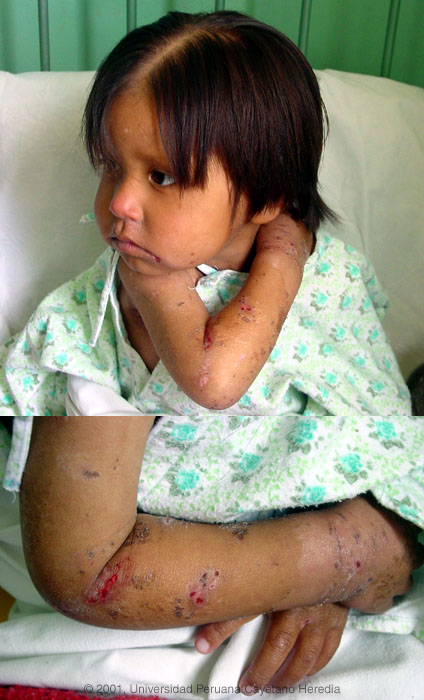2001 Case #6 |
 |
|
2001 Case #6
|
 |
|
| Diagnosis: Moderately severe Kwashiorkor |
| Discussion: In this child, weight for age was calculated at This child presents with a classical clinical presentation for edematous malnutrition and a classical epidemiologic history for the Andean highlands. Breastfeeding stopped several months earlier when another child was born. His diet then consisted primarily of potatoes and corn, the 2 crops that grow well at this altitude but which make for a diet high in carbohydrates but without any protein. Clinically, children with edematous malnutrition have swelling of the face, legs and arms, an apathetic and miserable affect, moon face, thin hair with weak roots, wasted weak muscles and often an enlarged liver. Non-specific diarrhea and vomiting perhaps due to GI damage is common. The edema may convince parents that the child is plump and well. Typical skin lesions include atrophy, patches of erythema, patches of either hyper or hypopigmentation and skin breakdown with ulceration; all found in our patient. The pruritic nature of some areas of the skin call into question the issue of scabies which is very common in this environment due the amount of infrequently washed clothing worn in large amounts in this harshly cold environment. As scabies mites are most often difficult to detect even with proper skin scraping and microscopy, scabies remains a clinical diagnosis in most cases and in Peru is most often treated with benzyl benzoate (inexpensive) or permethrin topically. Feeding should be started gradually and is divided into an initial and rehabilitation phases. Malnourished children do not tolerate the usual amounts of dietary protein or sodium. Too rapid initiation of feeding will lead to overhydration, severe metabolic imbalance and congestive heart failure, which if it occurs is an emergency. This patient was started on 0.5 gm protein/kg/day, with In addition, it is mandatory to give Vitamin A immediately upon admission to avoid blindness. The diet also contains Mg sulfate, Cu sulfate, Zn sulfate. The prognosis for this child in the environment to which he is returning is extremely poor. The parents will likely feel that the hospitalization has been detrimental when the plump fat child is returning as a much skinnier appearing child. Despite free government supplied vaccines in most of the neighboring larger communities to their village, the uptake and interest in rural areas has been poor due to cultural factors which do not incorporate the injection of foreign materials into the body into the overall belief system.
|
